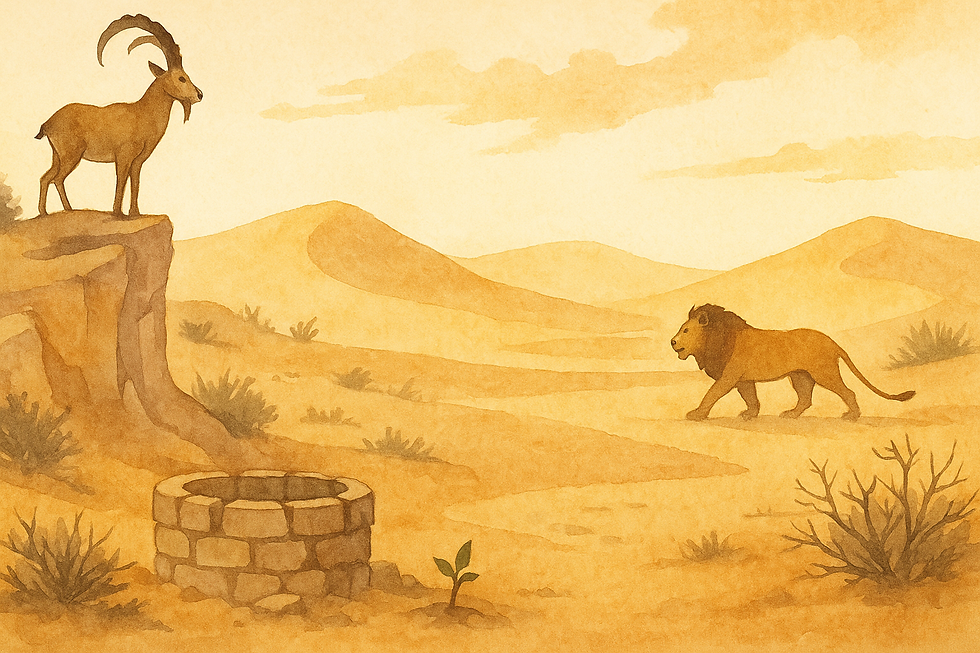The Silent Verdict of Dust and Bone
- Ross Boulton
- Jun 15
- 3 min read
Preemptive pride leaves only dust and bone.
By Forest Moss (c) 2025

In dunes of stones, baked and bare,
Where thorny shrubs in shadows stare,
Dwelt Ibex high on craggy spire,
And Lion prowled the golden mire.
A sly Fennec Fox with flickering ears
Whispered of Djinn-fire eggs in Lion’s lair,
And filled the Ibex’s heart with fears—
“Strike first,” he urged, “to guard our care.”
Ibex’s hoof skidded on trembling sand,
Its breath a gasp of grit and ash unplanned;
“Too late,” its silent conscience sighed,
Regret and pride now wrenched inside.
At dawn the Ibex’s horns rang clear,
Shattering dunes once kissed by dew;
Acrid scent of charred grass drew near,
As larks took wing and hope withdrew.
Above, a circling Vulture flew:
“I feed on dirges death itself once knew.”
Ibex shuddered at that hungry view,
Yet fear unraveled each cautious cue.
Lion hesitated—mane bent low—
Recalling shared victories long ago;
Its paw then faltered on the ridge’s crest,
And fury broke their fragile rest.
Echoes of Grief
“Our burrows burn,” lamented Mira mouse,
“Our songs lie hushed in hollow house.”
“No caravan’s fire brings balm at all,”
lamented Tark beside the smoldering wall.
A lone pale feather drifted by,
The echo of counsel swept sky-high.
A hush fell soft before the storm—
Silence cloaked each beating form;
Then thunder spoke its harsh, fateful tune,
And doom was writ beneath the noon.
Their final clash on shifting land
Cracked Zahara’s ancient stone of old;
Horns and paws in fateful stand
Left nothing but dust and bone.
Last Sight
Ash choked air upon the silent ridge,
Caravan tracks lay ghost and thin;
A lone Zahara seed in bone and sand
Stirs hope where ruin once had been.
Moral
“Let silence reign before the horn,
Else victory shatters into dust and bone—
For ivory horns and roaring paws
Will leave no breath to heal the land.”
Author's Notes
This fable dramatizes the cycle of preemptive strikes and reprisals—most directly the June 2025 Israel–Iran exchange—through desert‐dwelling animals and stark imagery. Here’s how its elements map onto the real‐world conflict and its broader lesson:
Ibex (Israel) and Lion (Iran)– The Ibex, perched atop its craggy outpost, represents a state that boasts advanced surveillance and a “first‐strike” posture. Its trembling hoof and inner conscience reflect the moral anguish that accompanies preemptive action.– The Lion embodies a neighboring power, proud of its sovereignty and quick to retaliate when provoked. Its moment of hesitation—“mane bent low”—hints at shared history (the “shared victory’s flow”) but gives way to wrath, underlining how revenge can override reason.
Fennec Fox and Vulture (Warmongers & Profiteers)– The Fox’s whisper of “Djinn-fire eggs” symbolizes fear-mongering over nuclear threats—anxiety stoked without hard proof.– The Vulture, circling above, thrives on the ruin that war produces, a stand-in for external actors or arms-profiteers that feed off conflict’s devastation.
Echoes of Grief (Civilians and Collateral Cost)– Mira the mouse and Tark the tortoise give voice to ordinary lives shattered by the strike‐and‐counterstrike. Their lament underscores that noncombatants—villagers, refugees, children—endure the heaviest burdens.
Omar’s Feather (Silenced Wisdom)– Omar the Owl’s lone drifting feather marks the absence of sober counsel. Though once present (in earlier drafts), here it nods to the idea that diplomatic voices and international inspectors were sidelined or ignored, with dire consequences.
“Dust and Bone” & “Zahara Seed” (Outcome and Hope)– The battlefield reduced to “dust and bone” crystallizes the fable’s tragic no-winner conclusion: both sides emerge weakened, and the land itself lies ravaged.– The final image of a single Zahara seed, buried but stirring, gestures toward the possibility of renewal—if only leaders learn to “let silence reign before the horn.”
Moral: “Let silence reign before the horn…”– The closing couplet warns that reflexive violence (“the horn”) begets mutual destruction. True security, the fable argues, requires pausing to listen, demanding proof, and allowing “silence” (dialogue, evidence, restraint) to hold sway before any strike.
In short, the fable is a cautionary allegory against preemptive warfare and the spiraling cycle of fear-driven escalation. By translating modern geopolitics into desert animals and elemental imagery, it lays bare how even “necessary” first blows can destroy everyone—not just militaries, but societies, landscapes, and the very hope of peace.



Comments